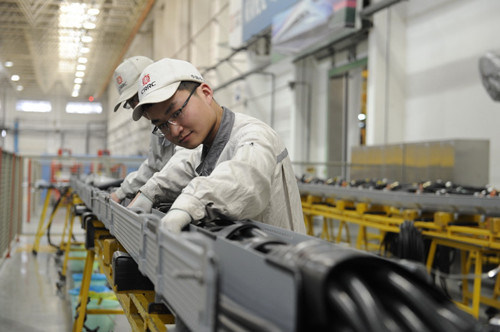Industrial sector gets a boost in first quarter


CRRC employees operate an assembly line of the company in Qingdao, Shandong province. [Photo by Zhang Jingang/For China Daily]
China's industrial sector made a strong start in the first quarter, with the industrial value-added output rising 6.8 percent year-on-year, the Ministry of Industry and Information Technology said on Wednesday.
The expansion came as the nation stepped up a gear in promoting supply-side structural reform and building itself into a manufacturing powerhouse, Chen Yin, chief engineer of the MIIT, said at a news conference.
Industrial production expanded at a steady pace, while the sector's profitability and entrepreneurial confidence improved, Chen said, citing official data.
Industrial value-added output in the first quarter grew 0.2 percentage point faster than in the whole of 2017, according to the ministry's data. During the period, the manufacturing sector's value-added output registered growth of 7 percent year-on-year.
Data showed the total profits of industrial enterprises expanded 16.1 percent in January and February, up 5.3 percentage points from last December.
"As the Made in China 2025 strategy advances, five key projects in areas such as integrated circuits, industrial robotics, new energy vehicles and new materials are picking up steam," Chen said.
"The manufacturing segment and the internet are being increasingly integrated, and the industrial sector continues to move toward the mid-to-high level."
China is attaching great importance to implementing the Made in China 2025 strategy, in a move to bolster its manufacturing competitiveness and bolster the global economy.
Between January and March, the added value of the high-tech manufacturing segment surged 11.9 percent year-on-year, while fixed-asset investment climbed 7.9 percent from the same period in previous year, according to the ministry's data. Both grew faster than the overall industrial sector.
Amid the drive to optimize the industrial sector, the ministry also continued to reduce steel capacity in the first quarter, aiming to meet the annual target, as well as slash overcapacity in the cement and plate glass sectors, MIIT spokesman Huang Libin told reporters.
"In the first quarter, the comprehensive utilization rate of the steel segment recovered to around 80 percent, a reasonable range," Huang said.
As for overall industrial capacity, the utilization rate in the period stood at 76.5 percent, up 0.7 percentage point year-on-year, the ministry's data showed.
Though the first quarter witnessed sound performance, China's industrial sector still faces considerable downward pressure, Chen said.
Constant endeavors will be made to sustain momentum in the sector, which faces challenges such as a complex and changeable environment, the adjustment of economic policies in major developed economies, and escalating international trade friction, Chen added.
Jin Bei, a researcher of the Chinese Academy of Social Sciences, said at a recent seminar that China needs to further foster innovation, develop high-quality products, and boost its manufacturing industry in an all-round and multi-dimensional manner.
MOST POPULAR
- 1 China to give visa-free treatment to another 9 countries
- 2 China fully opens manufacturing sector to foreign investors in landmark opening up move
- 3 China's import expo attracts record-breaking participating countries, exhibitors
- 4 China's door opening even wider to foreign visitors, businesses
- 5 China revises rules to ease foreign strategic investment in listed firms
Editors' Picks
 Infographic:
China's public holidays for 2025
Infographic:
China's public holidays for 2025
 Infographic:
Basic facts of APEC
Infographic:
Basic facts of APEC
 Infographic:
Wrapping up the 7th CIIE: Data recap
Infographic:
Wrapping up the 7th CIIE: Data recap




